Overview
Automatic visa revalidation offers a lifeline for certain nonimmigrant healthcare workers, allowing them to re-enter the U.S. with an expired visa after brief travel to Canada, Mexico, or adjacent islands. But to take advantage of this provision, it’s crucial to meet specific eligibility criteria.
Have you ever felt overwhelmed by confusing immigration processes? Maintaining lawful nonimmigrant status, possessing valid documentation, and adhering to travel restrictions are essential steps that can facilitate smoother re-entry for eligible individuals.
Remember, you’re not alone in this fight—we’re here to help you navigate these challenges.
Introduction
Automatic Visa Revalidation (AVR) is a crucial lifeline for immigrant healthcare workers facing the complexities of U.S. immigration regulations. This provision allows eligible nonimmigrants to re-enter the country even with an expired visa stamp, as long as they meet specific criteria and travel to designated nearby locations. Yet, the intricacies of AVR can lead to confusion, raising important questions about eligibility and compliance.
How can healthcare professionals ensure a smooth re-entry while following these regulations? What steps must they take to avoid potential pitfalls? This guide aims to clarify the AVR process, providing essential insights and practical advice for those eager to leverage this valuable immigration benefit.
Remember, you’re not alone in this fight—we’re here to support you every step of the way.
Define Automatic Visa Revalidation
is a crucial provision in American immigration law that permits certain nonimmigrants to with an expired stamp in their passport after a brief trip to Canada, Mexico, or nearby islands, as long as the journey does not exceed 30 days. This process is especially beneficial for who may need to or , as automatic visa revalidation alleviates the need to update their permit before re-entry.
However, it’s important to note that automatic visa revalidation (AVR) is not available to travelers who apply for a new permit while abroad or who have violated their immigration status during their time in the U.S. To qualify for automatic visa revalidation, individuals must:
- Maintain their nonimmigrant status
- Possess including a Form I-94 and an unexpired passport
- Not be from countries identified as sponsors of terrorism
Remember, Cuba is not included in the list of adjacent islands for eligibility. We understand how can be, but you’re not alone in navigating this process—we’re here to .
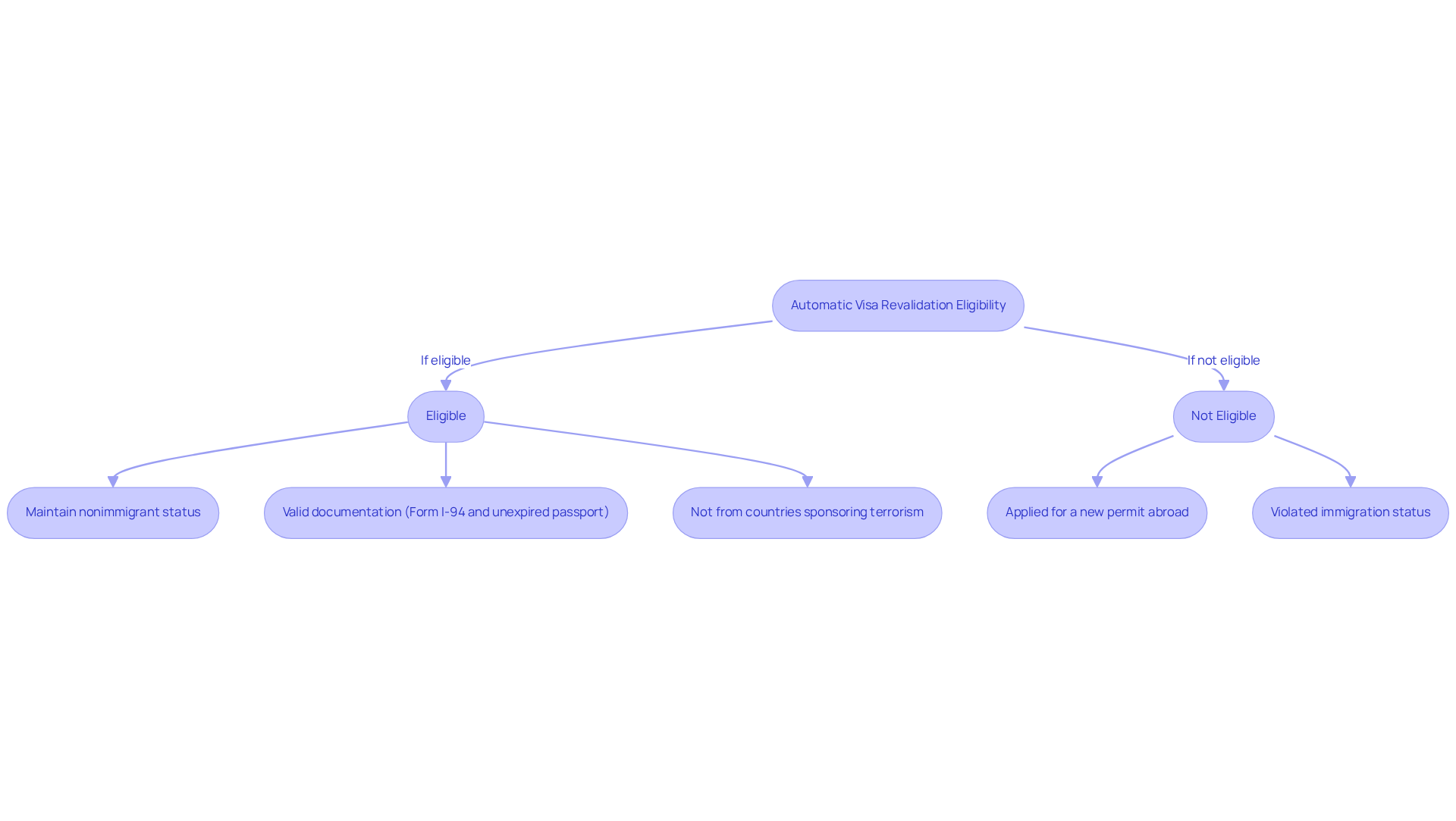
Identify Eligibility Requirements
To qualify for , individuals must meet several important criteria:
- Valid : You need to maintain lawful when re-entering the U.S. This is crucial for a smooth process.
- Expired Permit: Your passport must show an outdated stamp, but don’t worry—you should still have a .
- : Travel is limited to Canada, Mexico, or adjacent islands, with your stay not exceeding 30 days. Eligible islands include The Bahamas, Barbados, Bermuda, Dominican Republic, Haiti, Jamaica, Martinique, St. Pierre and Miquelon, Trinidad, and various Caribbean islands.
- No : It’s essential that you have not submitted a new permit application while outside the U.S. If you have a new application pending, [automatic visa revalidation](https://blog.vasquezlawnc.com/best-truck-accident-lawyers-vs-personal-injury-lawyers-key-differences) cannot be utilized.
- : You must not have violated any terms of your nonimmigrant status during your stay in the U.S. Importantly, if you’ve been refused entry to Canada or Mexico, you will also be barred from re-entering the U.S. under automatic visa revalidation.
Recent changes in 2025 have clarified these eligibility requirements, emphasizing the need to maintain your nonimmigrant status and comply with immigration laws. Statistics show that many nonimmigrants face difficulties when reapplying for permits due to status violations, highlighting the importance of strict adherence to these criteria. If you are a holding F, J, H, L, O, or P permits, and you travel to qualifying countries while following these guidelines, you can successfully utilize automatic visa revalidation. This ensures a smoother re-entry process for you.
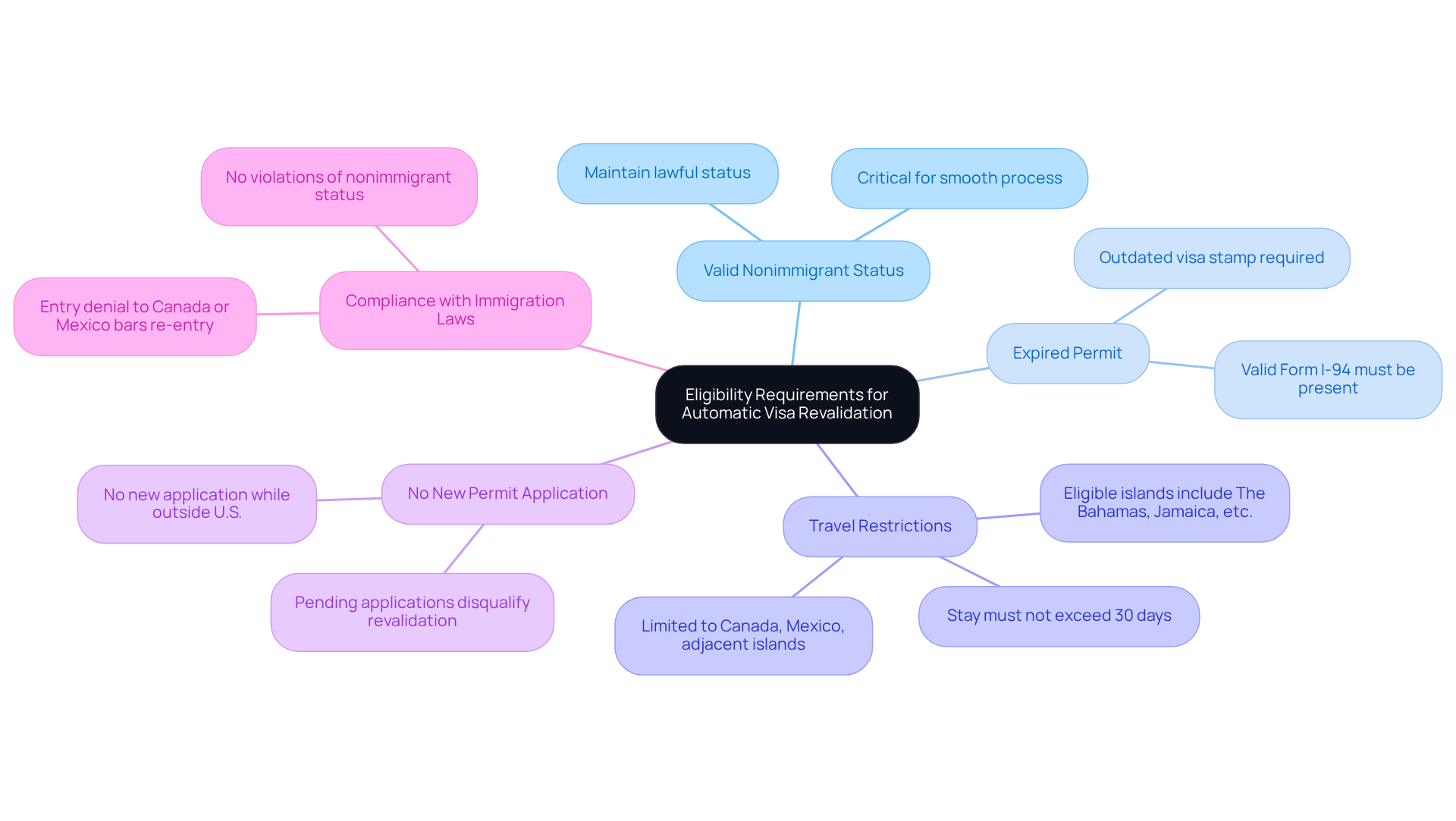
Outline Revalidation Procedures
To effectively navigate , follow these essential steps:
- Check : Confirm your visa is expired, but ensure you possess a valid I-94 form, indicating your lawful status in the U.S.
- Plan Your Travel: Travel only to Canada, Mexico, or adjacent islands, ensuring your trip does not exceed 30 days to qualify for revalidation.
- Gather Required Documents: Carry your passport (with the expired visa), valid I-94, and any pertinent documentation, such as employment letters or proof of your healthcare worker status.
- Re-entry to the United States: Upon your return, present your documents to the Customs and Border Protection (CBP) officer at the port of entry, clearly stating your intention to re-enter under the .
- Answer Questions: Be prepared to respond to inquiries regarding your travel and . The CBP officer has the authority to grant or deny re-entry based on your eligibility.
- Maintain Documentation: Keep copies of all documents and any correspondence related to your immigration status for future reference.
Eligibility for Automatic Revalidation includes having an expired in specific categories such as B, F, J, M, TN, and certain H classifications. are notably high for eligible individuals who follow these guidelines. Real-world examples show that travelers who fulfill the requirements, including possessing certain permit types and maintaining valid I-94 forms, can navigate the smoothly. As Felipe Jimenez, an Associate Attorney, points out, 'Grasping the subtleties of your immigration status is vital for a successful re-entry process.' By following this step-by-step guide, you can ensure compliance with U.S. immigration regulations while minimizing potential complications. Remember, Automatic Revalidation is not available for individuals who have submitted an application for a new permit or have been refused entry previously.
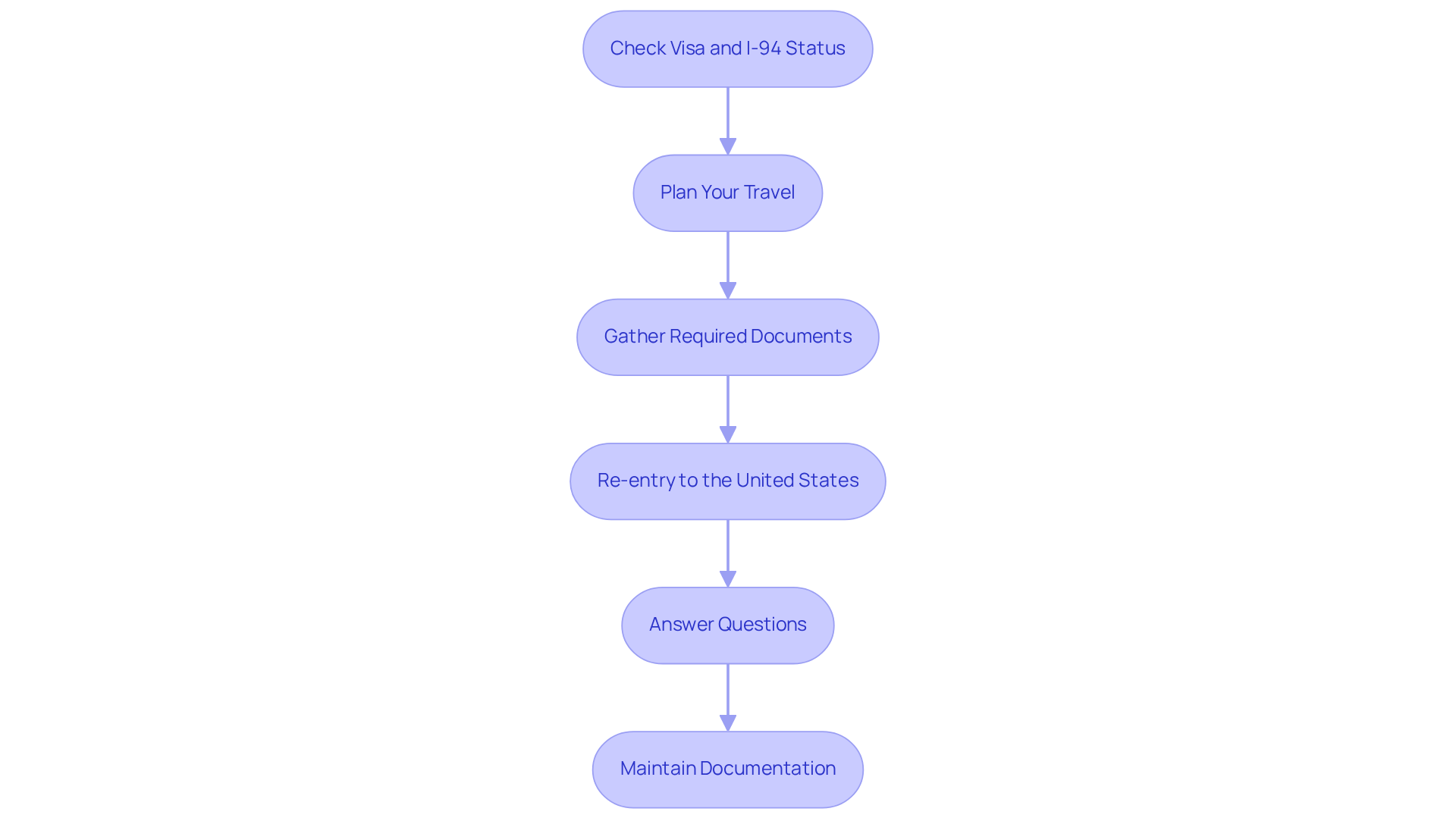
Address Common Questions and Scenarios
Here are some common questions and scenarios related to :
-
What if my is expired, but my I-94 is also expired?
- You are not eligible for AVR. Renewal of your visa is necessary before re-entering the U.S.
-
Can I visit other countries apart from Canada or Mexico?
- No, AVR is strictly applicable to . Any travel to other countries disqualifies you from automatic visa revalidation.
-
What occurs if I request a new permit while overseas?
- means you cannot utilize AVR. You must wait for the to be issued before re-entering the U.S.
-
How do I prove my eligibility at the port of entry?
- At the port of entry, present your , , and any and purpose of travel. Ensure you have a valid (unexpired) admission stamp or Form I-94, as this is crucial for proving your eligibility.
-
What if I have a pending application for a change of status?
- If you have a pending application, AVR is not an option. You must await the decision on your application before traveling.
-
What are the circumstances under which I must reapply for a travel document?
- You must if you have been outside the U.S. for more than thirty days or if you have applied for a new visa while abroad. According to the U.S. Department of State, "the requirement is that they departed from the U.S. to Canada or Mexico for 30 days or less and possess a valid (unexpired) admission stamp or paper Form I-94.
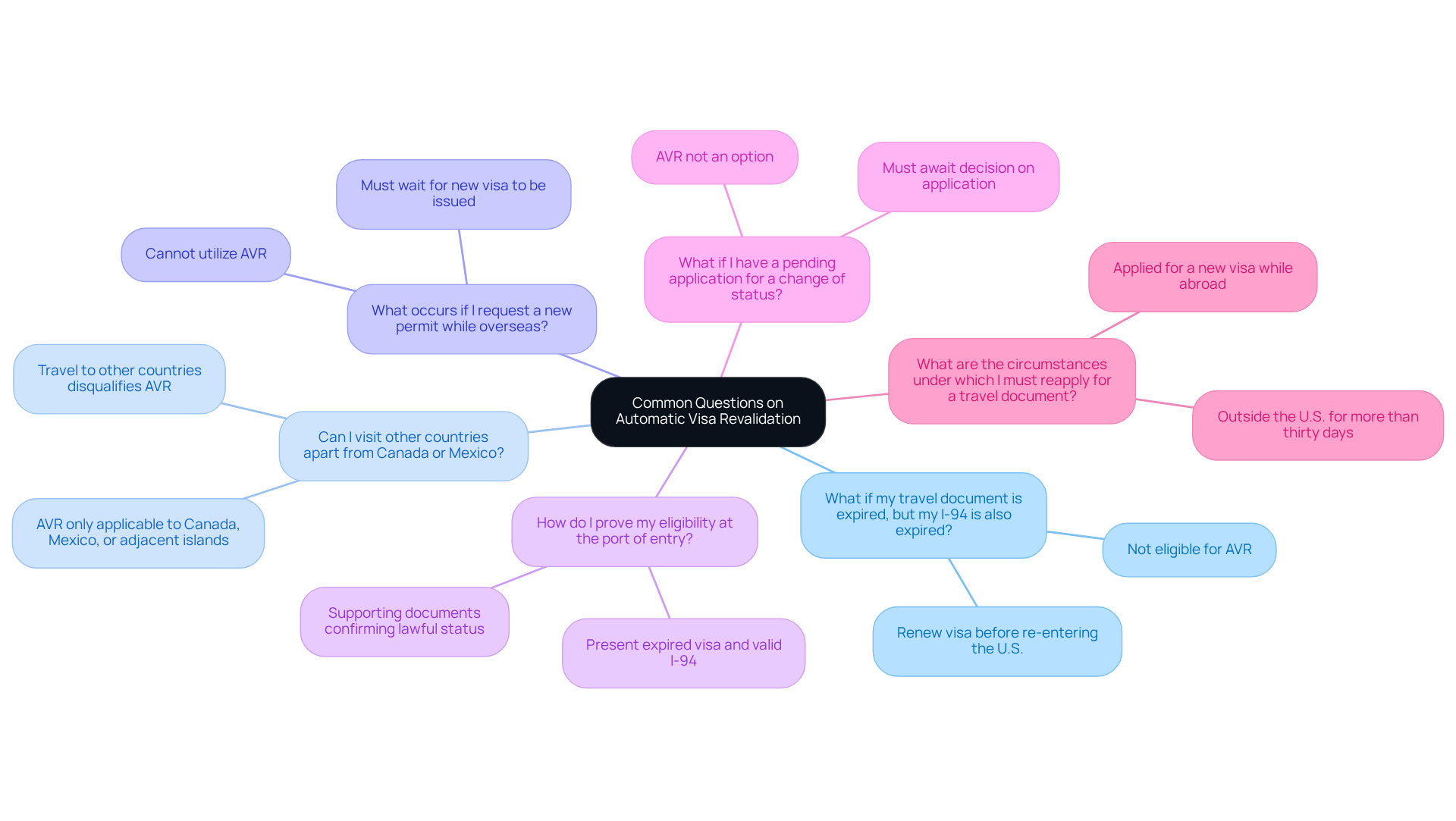
Additional Considerations for Healthcare Workers
Healthcare workers, as you plan your travel and utilize (AVR), consider these vital factors:
- Employer Policies: Have you consulted your employer about their ? Understanding the specific is crucial. Many employers have established guidelines that can significantly impact your journey arrangements. For instance, 44% of large employers currently offer a or plan to in 2023, which could influence your travel options.
- Impact on Employment: Is your travel aligned with your employment obligations? Disruptions in your work schedule can affect your standing with your employer, especially in critical healthcare roles. It’s essential to ensure that your journey does not jeopardize your position.
- : Are you aware of the health and safety regulations that might affect your travel? Staying informed is vital, particularly given ongoing public health concerns. Compliance with these regulations is not just about following the rules; it’s about ensuring your safety and that of your patients.
- : Do you have questions about your eligibility for AVR or the process itself? can be a game changer, especially if your situation is complex. Remember, nonimmigrants must possess a valid admission stamp or paper Form I-94 to be eligible for automatic visa revalidation. Don’t hesitate to reach out for the help you need.
- Stay Informed: How often do you update yourself on changes in immigration law? Regularly checking for updates can safeguard your residency status and the AVR process. For example, travelers who have been outside the U.S. for more than thirty days must reapply for a visa to reenter. Immigration regulations evolve, and being informed can help you avoid complications during your travels.
We’re here to support you in navigating these challenges. Your journey matters, and we stand ready to fight for your rights and clarity in these critical moments.
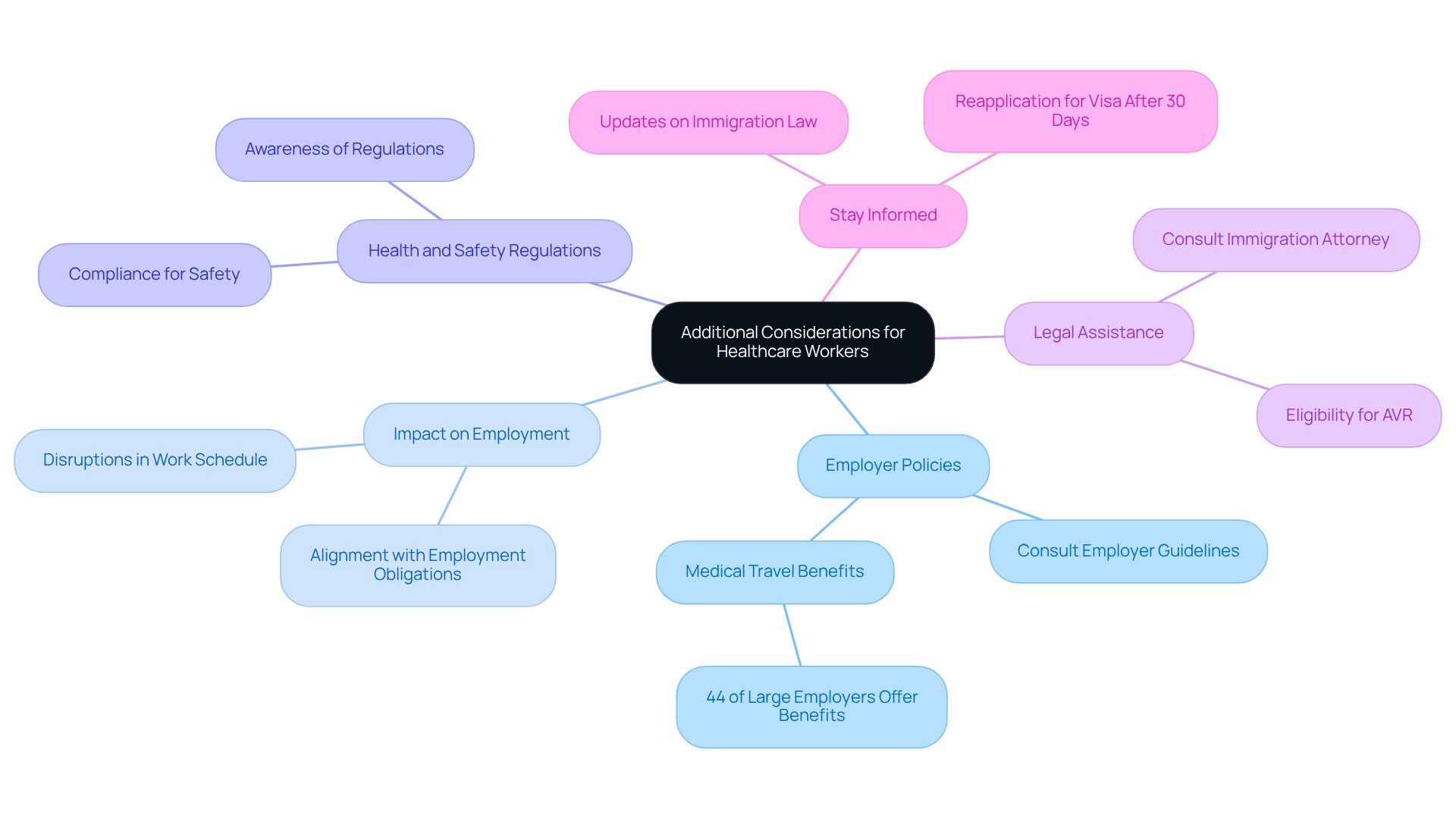
Conclusion
Automatic Visa Revalidation (AVR) is a crucial lifeline for nonimmigrant healthcare workers. It allows them to re-enter the United States even with an expired visa stamp after a brief trip to Canada, Mexico, or certain nearby islands. This provision simplifies travel logistics and ensures that healthcare professionals can juggle their personal and work commitments without the added stress of visa complications.
Throughout this article, we’ve outlined key eligibility requirements for AVR. Maintaining nonimmigrant status, possessing valid documentation, and adhering to specific travel restrictions are essential. The step-by-step procedures for revalidation underscore the importance of preparation and compliance with immigration laws, ensuring a smoother re-entry process. Additionally, addressing common questions and scenarios provides clarity and reassurance for those navigating this complex system.
In summary, understanding and utilizing Automatic Visa Revalidation is vital for immigrant healthcare workers who wish to travel without jeopardizing their immigration status. Staying informed about eligibility criteria and procedures can significantly reduce the risk of complications during travel. As immigration regulations continue to evolve, it’s crucial for individuals to seek legal assistance when needed and remain proactive in managing their immigration status. The journey may be challenging, but with the right knowledge and support, successful re-entry into the U.S. is within reach. Remember, we’re here to fight for your family and your future matters to us.
Frequently Asked Questions
What is Automatic Visa Revalidation?
Automatic visa revalidation is a provision in American immigration law that allows certain nonimmigrants to re-enter the U.S. with an expired visa stamp in their passport after a brief trip to Canada, Mexico, or nearby islands, as long as the trip does not exceed 30 days.
Who benefits from Automatic Visa Revalidation?
Immigrant healthcare professionals and other nonimmigrants benefit from automatic visa revalidation as it eliminates the need to update their visa before re-entering the U.S. after short trips.
What are the eligibility requirements for Automatic Visa Revalidation?
To qualify, individuals must maintain valid nonimmigrant status, possess valid documentation including a Form I-94 and an unexpired passport, not be from countries identified as sponsors of terrorism, and ensure their travel is limited to Canada, Mexico, or certain adjacent islands for no more than 30 days.
What documentation is required for Automatic Visa Revalidation?
Individuals must have a valid Form I-94 (Arrival/Departure Record) and an unexpired passport to qualify for automatic visa revalidation.
Are there any travel restrictions for Automatic Visa Revalidation?
Yes, travel is limited to Canada, Mexico, or adjacent islands, and the stay must not exceed 30 days. Eligible islands include The Bahamas, Barbados, Bermuda, Dominican Republic, Haiti, Jamaica, Martinique, St. Pierre and Miquelon, Trinidad, and various Caribbean islands.
Can I apply for a new permit while outside the U.S.?
No, individuals cannot submit a new permit application while outside the U.S. If a new application is pending, automatic visa revalidation cannot be utilized.
What happens if I have violated my immigration status?
If you have violated any terms of your nonimmigrant status during your stay in the U.S., you will not qualify for automatic visa revalidation. Additionally, if you have been refused entry to Canada or Mexico, you will also be barred from re-entering the U.S. under this provision.
What changes were made to the eligibility requirements in 2025?
Recent changes in 2025 clarified the eligibility requirements, emphasizing the need to maintain nonimmigrant status and comply with immigration laws, which is crucial for a smooth re-entry process.




